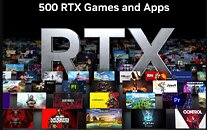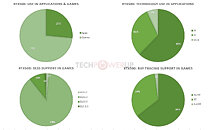- Joined
- Oct 9, 2007
- Messages
- 47,617 (7.44/day)
- Location
- Dublin, Ireland
| System Name | RBMK-1000 |
|---|---|
| Processor | AMD Ryzen 7 5700G |
| Motherboard | Gigabyte B550 AORUS Elite V2 |
| Cooling | DeepCool Gammax L240 V2 |
| Memory | 2x 16GB DDR4-3200 |
| Video Card(s) | Galax RTX 4070 Ti EX |
| Storage | Samsung 990 1TB |
| Display(s) | BenQ 1440p 60 Hz 27-inch |
| Case | Corsair Carbide 100R |
| Audio Device(s) | ASUS SupremeFX S1220A |
| Power Supply | Cooler Master MWE Gold 650W |
| Mouse | ASUS ROG Strix Impact |
| Keyboard | Gamdias Hermes E2 |
| Software | Windows 11 Pro |
NVIDIA today announced the important milestone of 500 games and apps that take advantage of NVIDIA RTX, the transformative set of gaming graphics technologies, that among many other things, mainstreamed real-time ray tracing in the consumer gaming space, and debuted the most profound gaming technology of recent times—DLSS, or performance uplifts through high-quality upscaling technologies. The company got to this milestone over a 5-year period, with RTX seeing the light of the day in August 2018. NVIDIA RTX is the combined feature-set of real time ray tracing, including NVIDIA-specific enhancements; and DLSS.
Although it started out as an upscaling-based performance enhancement that leverages AI, DLSS encompasses a whole suite of technologies aimed at enhancing performance at minimal quality loss, and in some cases even enhances the image quality over native resolution. This includes super resolution, or the classic DLSS and DLSS 2 feature set; DLSS 3 Frame Generation, which nearly doubles frame-rates by generating entire alternate frames entirely using AI, without involving the graphics rendering machinery; and DLSS 3.5 Ray Reconstruction, which attempts to vastly improve the fidelity of ray traced elements in upscaled scenarios.

NVIDIA put out some interesting usage stats about RTX, which see Cyberpunk 2077 as the most popular title with RTX, given its large install base. Over 97% of gamers that play it on NVIDIA GPUs do so with ray tracing and/or DLSS enabled. This is closely followed by Naraka: Bladepoint at 98%, and Minecraft RTX at 99%, Alan Wake 2 at 99%, and Diablo IV at 96% (the stats take into account the gamer install-base).



NVIDIA put out the complete list of games and applications that support NVIDIA RTX technologies. We have pieced together some insights on the extent to which individual RTX technologies are in use with games that are part of the RTX ecosystem, and the various DLSS features they support.

To begin with, nearly 75% of the software in the NVIDIA RTX ecosystem are games, as expected, but there's also a larger-than expected group of non-gaming applications benefit from NVIDIA RTX, too. These include creator tools, and applications that leverage the NVIDIA Omniverse ecosystem.
Another surprising set of data has to do with top-level RTX technologies in use among applications—whether it's AI, ray tracing, or DLSS. Here, NVIDIA says that a whopping 62% of the software leverage accelerated AI in some form, taking advantage of the AI acceleration hardware with RTX GPUs. A respectable 31% of the applications in the RTX ecosystem support ray tracing, which has been the biggest driver of gaming technology for NVIDIA—you buy an RTX GPU for its ray tracing capabilities. 7% of the applications leverage the DLSS feature-set.
Among the DLSS family of features, DLSS 1 and DLSS 2 super resolution makes up a whopping 89% of the DLSS implementation across games. a respectable 10% now features DLSS 3 Frame Generation, a feature that's exclusive to RTX 40-series "Ada" GPUs; and 1% uses the latest DLSS 3.5 Ray Reconstruction feature that supports both RTX 30-series "Ampere" and RTX 40-series "Ada" GPUs.
Lastly, among the applications in the RTX ecosystem, 64% lack ray tracing support (a data point that agrees with the second graph); 34% implements ray tracing in some shape or form; and 2% implements "full ray tracing," using technologies such as path tracing.
View at TechPowerUp Main Site
Although it started out as an upscaling-based performance enhancement that leverages AI, DLSS encompasses a whole suite of technologies aimed at enhancing performance at minimal quality loss, and in some cases even enhances the image quality over native resolution. This includes super resolution, or the classic DLSS and DLSS 2 feature set; DLSS 3 Frame Generation, which nearly doubles frame-rates by generating entire alternate frames entirely using AI, without involving the graphics rendering machinery; and DLSS 3.5 Ray Reconstruction, which attempts to vastly improve the fidelity of ray traced elements in upscaled scenarios.

NVIDIA put out some interesting usage stats about RTX, which see Cyberpunk 2077 as the most popular title with RTX, given its large install base. Over 97% of gamers that play it on NVIDIA GPUs do so with ray tracing and/or DLSS enabled. This is closely followed by Naraka: Bladepoint at 98%, and Minecraft RTX at 99%, Alan Wake 2 at 99%, and Diablo IV at 96% (the stats take into account the gamer install-base).



NVIDIA put out the complete list of games and applications that support NVIDIA RTX technologies. We have pieced together some insights on the extent to which individual RTX technologies are in use with games that are part of the RTX ecosystem, and the various DLSS features they support.

To begin with, nearly 75% of the software in the NVIDIA RTX ecosystem are games, as expected, but there's also a larger-than expected group of non-gaming applications benefit from NVIDIA RTX, too. These include creator tools, and applications that leverage the NVIDIA Omniverse ecosystem.
Another surprising set of data has to do with top-level RTX technologies in use among applications—whether it's AI, ray tracing, or DLSS. Here, NVIDIA says that a whopping 62% of the software leverage accelerated AI in some form, taking advantage of the AI acceleration hardware with RTX GPUs. A respectable 31% of the applications in the RTX ecosystem support ray tracing, which has been the biggest driver of gaming technology for NVIDIA—you buy an RTX GPU for its ray tracing capabilities. 7% of the applications leverage the DLSS feature-set.
Among the DLSS family of features, DLSS 1 and DLSS 2 super resolution makes up a whopping 89% of the DLSS implementation across games. a respectable 10% now features DLSS 3 Frame Generation, a feature that's exclusive to RTX 40-series "Ada" GPUs; and 1% uses the latest DLSS 3.5 Ray Reconstruction feature that supports both RTX 30-series "Ampere" and RTX 40-series "Ada" GPUs.
Lastly, among the applications in the RTX ecosystem, 64% lack ray tracing support (a data point that agrees with the second graph); 34% implements ray tracing in some shape or form; and 2% implements "full ray tracing," using technologies such as path tracing.
View at TechPowerUp Main Site

